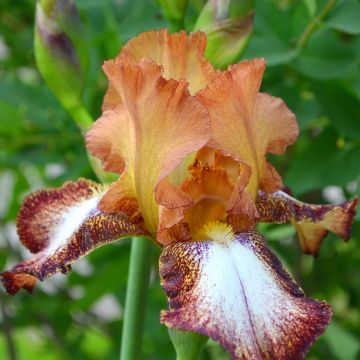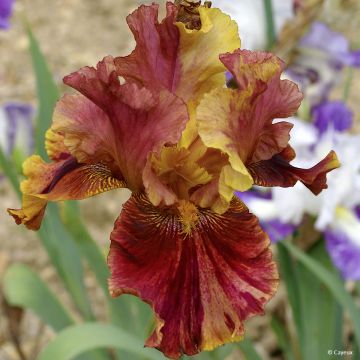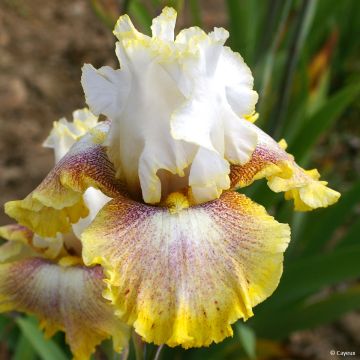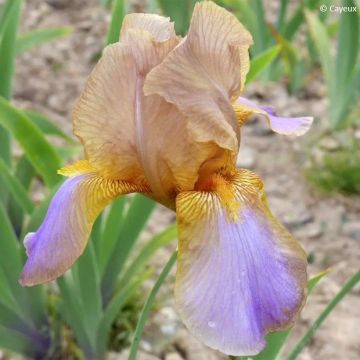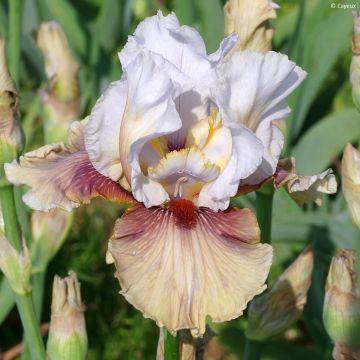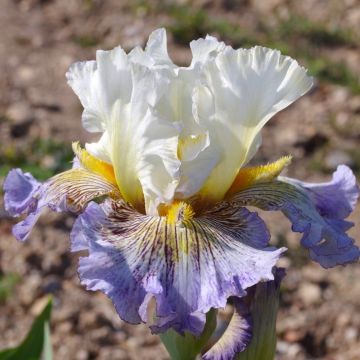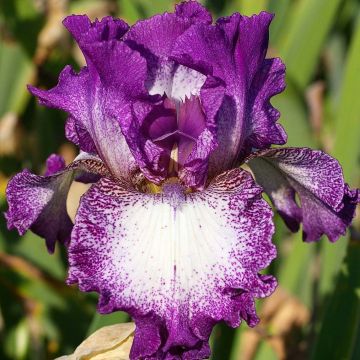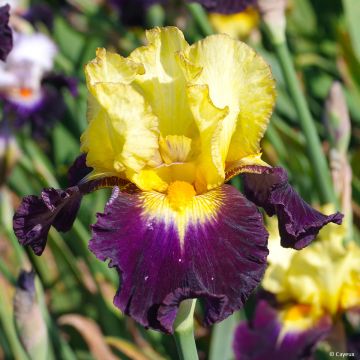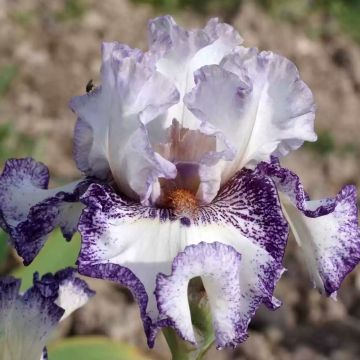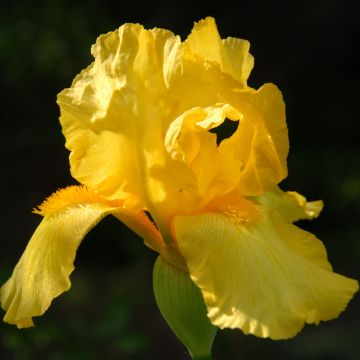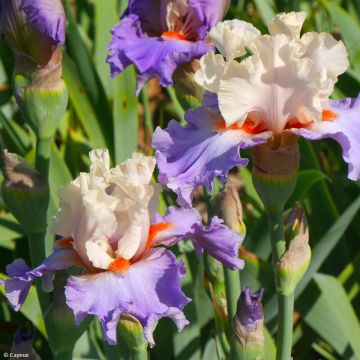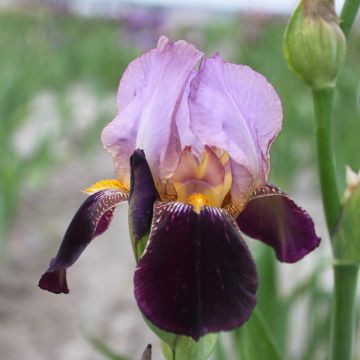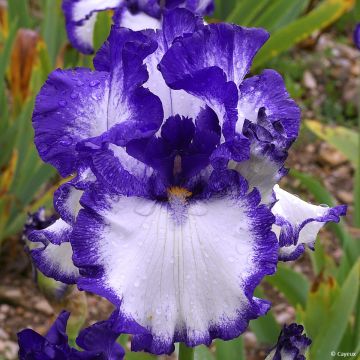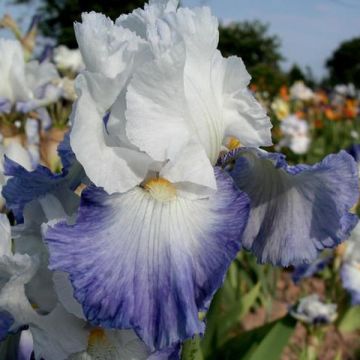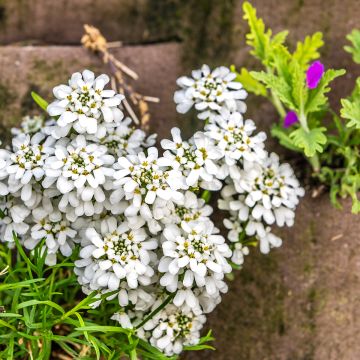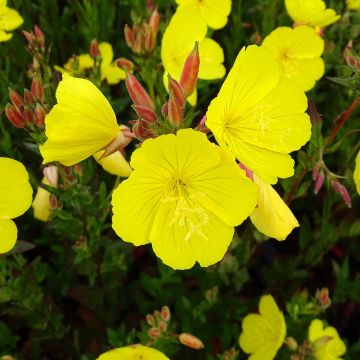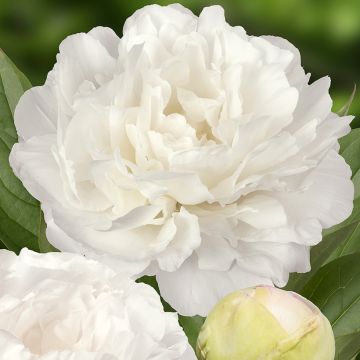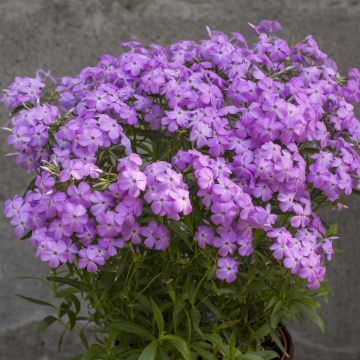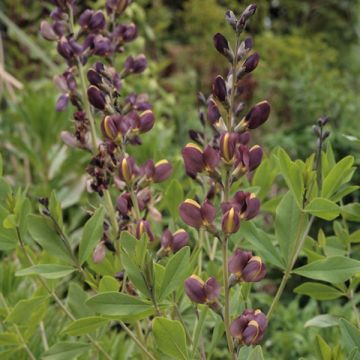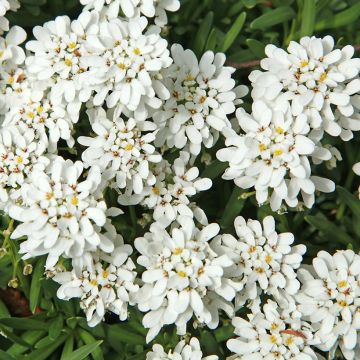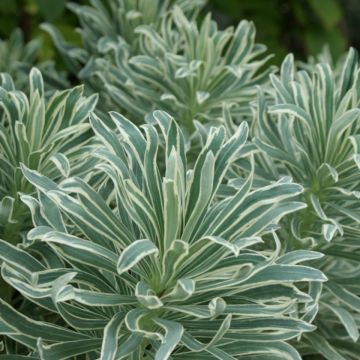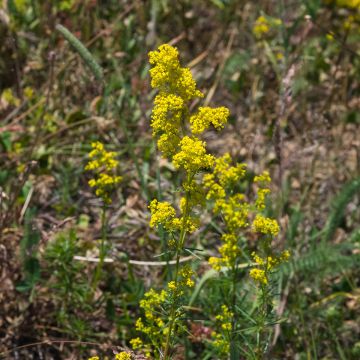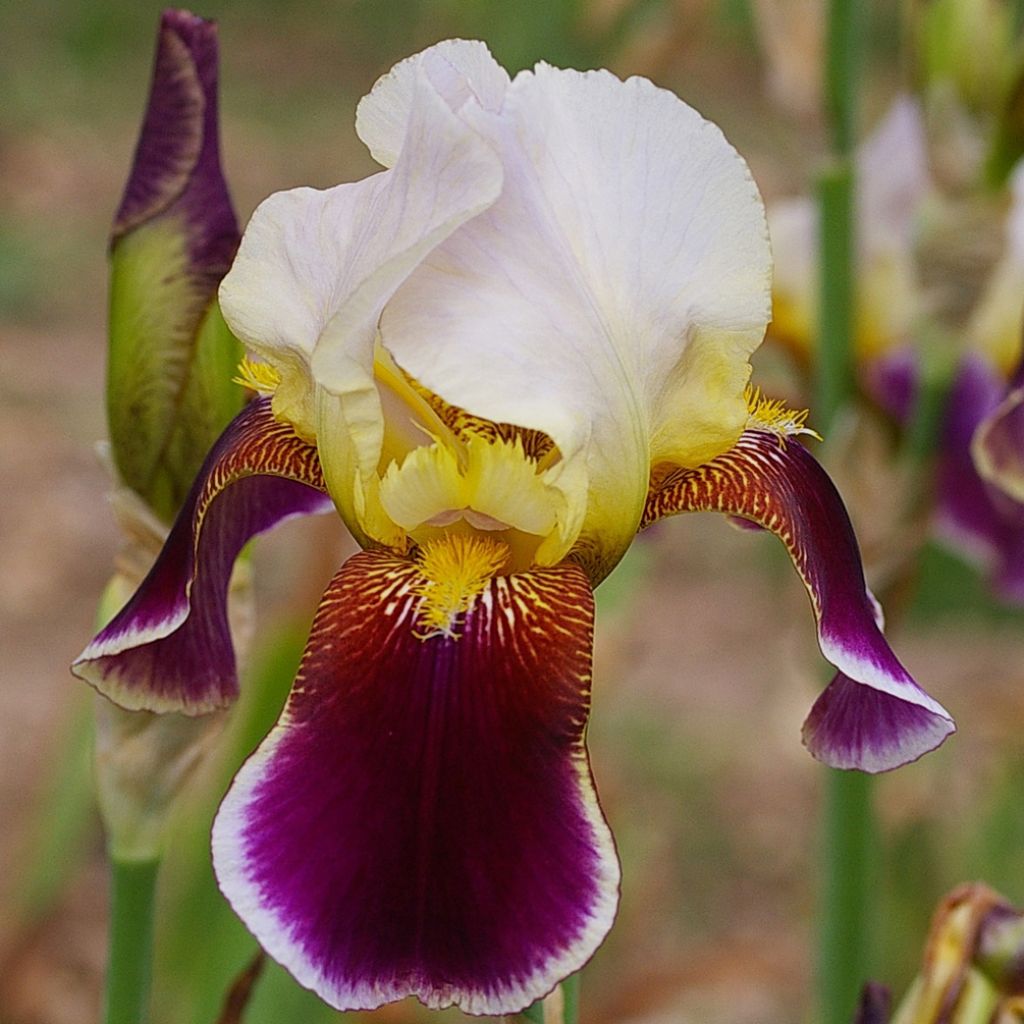

Iris germanica Shah Jehan - Iris des Jardins
Iris Shah Jehan - Tall Bearded Iris
Iris germanica Shah Jehan
German Iris, Bearded Iris
Why not try an alternative variety in stock?
View all →This plant carries a 12 months recovery warranty
More information
We guarantee the quality of our plants for a full growing cycle, and will replace at our expense any plant that fails to recover under normal climatic and planting conditions.
From €7.90 for pickup delivery and €6.90 for home delivery
Express home delivery from €8.90.
From €7.90 for pickup delivery and €6.90 for home delivery
Express home delivery from €8.90.

Does this plant fit my garden?
Set up your Plantfit profile →
Description
Iris 'Shah Jehan', a tall bearded iris, is an ancient variety which caused a sensation among iris enthusiasts when it was released in 1932. Its slender and elegant stems bear purely shaped flowers in May, admittedly of modest size, but adorned with rich and vibrant shades that are difficult to describe. They consist of blue-washed white petals that dominate purple sepals with a purple centre. The flower's throat is golden yellow to buff, veined with garnet, under bright orange beards. The plant quickly forms sumptuous, elegant, and very vigorous clumps. This historic and classy iris excels in slightly wild or poor areas of the garden, accompanied by white flowers.
The 'Shah Jehan' Iris is a rhizomatous and deciduous perennial plant, with an upright tufted habit from spring. It belongs to the Iridaceae family. It is one of the many cultivars obtained over centuries, with controversial origins that revolve around the number of chromosomes of potential ancestors. It should be noted that Garden Irises have European origins. This iris is of good size, reaching a height of 85 to 90 cm (34 to 35in) when in bloom, with numerous slender and pointed buds, and the clump will spread indefinitely over time, with the central rhizomes becoming bare in favour of the outer rhizomes. The 'Shah Jehan' Iris has an elegant upright habit in dense tufts of long sword-shaped, glaucous green and highly veined leaves. Floral stems appear in April and bloom in May, from the top to the lower branches. The colour is enhanced by the velvety texture of the petals and sepals. It's worth noting that the flowers are also very fragrant.
Obtained by W.Neel, 1932.
To accompany irises, choose plants based on their needs (exposure, soil...), growth (low-growing or light-foliaged plants), decorative appearance and flowering time. For example, Gauras will cast little shade on the irises and keep the faded iris bed attractive throughout the summer. Eschscholzias will be satisfied with dry and poor soil, just like the iris. Geraniums, salvias, and Libertia also complement irises very well. Slopes and terraced edges will be stabilised by a dense planting of old diploid varieties that require little care. If the goal is more decorative and access for maintenance is possible, one can choose more modern varieties, such as intermediates that are less likely to be knocked over.
At the foot of a wall, the shelter from the wind allows for the use of tall irises. They can of course be planted in the foreground of shorter and earlier varieties.
Border: the entire range can be used, from early dwarfs under 40 cm (16in), to tall irises over 75 cm (30in) that flower in May, including intermediates (in terms of size and earliness) and border irises, which are medium-sized but flower at the same time as the tall ones. Tall irises may need staking to prevent them from being blown over.
Mass planting: the domain of border irises, but also dwarfs, depending on the circumstances.
Mixed border: the entire range of sizes can be used, chosen according to the position (foreground, background) and the size of the surrounding plants.
Iris bed, iris garden: the paradise of the iris enthusiast, where the choice and arrangement of varieties reflect each individual's taste. The use of the entire range of bearded irises allows for two and a half months of flowers in spring. The choice of so-called reblooming irises offers some additional flowers in late summer or autumn.
The vegetable garden can be embellished with a few clumps or borders of irises for cutting.
Iris Shah Jehan - Tall Bearded Iris in pictures
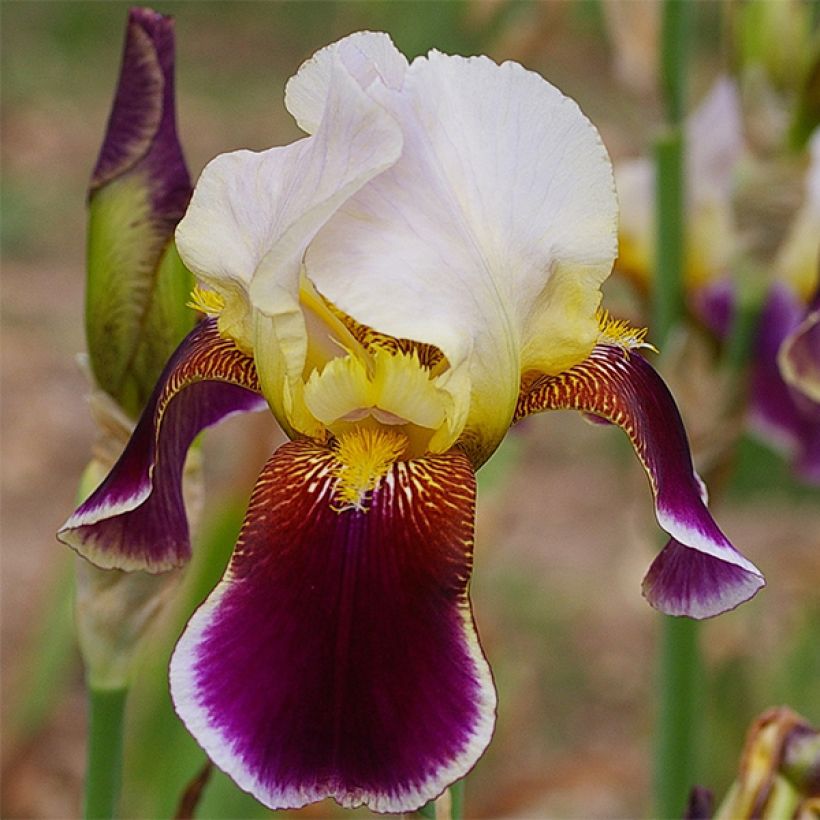

Flowering
Foliage
Plant habit
Botanical data
Iris
germanica
Shah Jehan
Iridaceae
German Iris, Bearded Iris
Cultivar or hybrid
Other German Iris - Bearded Iris
Planting and care
Do you have a sunny, warm location, rather dry in summer?
This is the ideal location for irises! In the shade, they grow but do not flower. They are hardy and do not need winter protection. Well-drained soil is perfect, even dry and chalky. Excessively wet soil promotes rhizome rot. Plant from July to September. This allows the rhizomes to grow and develop new roots before winter. They should be planted as soon as they are purchased for best results. Plan to divide irises every 4 years or so to give them fresh soil. They have vigorous growth and require space to develop and flower well. Plant with spacing adapted to the size and vigour of the variety: about 34-50 cm (13-20in) for tall varieties. In a monochrome planting, the rhizomes are planted in a staggered pattern. To create a mix of colours, plant them in groups of several plants of the same variety. Always consider the direction of rhizome growth by arranging them in a star pattern, with buds and leaves facing outward, and spacing them well away from other varieties to allow them room to develop.
Planting
Dig a hole that is wide and deep enough. Create a conical mound of soil on which the rhizome and spread-out roots are placed. Cover the roots. It is important for the rhizome to be left just above the surface of the soil. It should not be planted in a dip (risk of rot), so anticipate that the soil will settle and the iris will sink. In clayey or damp soil, the rhizome can even be left elevated on a slight mound. To make the soil stick to the roots, lightly firm and water abundantly after planting. Water 2-3 times if necessary until it is established.
Maintenance:
Keep the soil weed-free by lightly hoeing, taking care not to damage the rhizomes or roots. Weeds create shade for the irises, retain moisture (causing rot), and attract slugs. Similarly, remove dry leaves. If they are diseased (with reddish-brown bordered spots of heterosporiosis), burn them. Remove faded flowers.
Planting period
Intended location
Care
Spring flowering perennials
Haven't found what you were looking for?
Hardiness is the lowest winter temperature a plant can endure without suffering serious damage or even dying. However, hardiness is affected by location (a sheltered area, such as a patio), protection (winter cover) and soil type (hardiness is improved by well-drained soil).

Photo Sharing Terms & Conditions
In order to encourage gardeners to interact and share their experiences, Promesse de fleurs offers various media enabling content to be uploaded onto its Site - in particular via the ‘Photo sharing’ module.
The User agrees to refrain from:
- Posting any content that is illegal, prejudicial, insulting, racist, inciteful to hatred, revisionist, contrary to public decency, that infringes on privacy or on the privacy rights of third parties, in particular the publicity rights of persons and goods, intellectual property rights, or the right to privacy.
- Submitting content on behalf of a third party;
- Impersonate the identity of a third party and/or publish any personal information about a third party;
In general, the User undertakes to refrain from any unethical behaviour.
All Content (in particular text, comments, files, images, photos, videos, creative works, etc.), which may be subject to property or intellectual property rights, image or other private rights, shall remain the property of the User, subject to the limited rights granted by the terms of the licence granted by Promesse de fleurs as stated below. Users are at liberty to publish or not to publish such Content on the Site, notably via the ‘Photo Sharing’ facility, and accept that this Content shall be made public and freely accessible, notably on the Internet.
Users further acknowledge, undertake to have ,and guarantee that they hold all necessary rights and permissions to publish such material on the Site, in particular with regard to the legislation in force pertaining to any privacy, property, intellectual property, image, or contractual rights, or rights of any other nature. By publishing such Content on the Site, Users acknowledge accepting full liability as publishers of the Content within the meaning of the law, and grant Promesse de fleurs, free of charge, an inclusive, worldwide licence for the said Content for the entire duration of its publication, including all reproduction, representation, up/downloading, displaying, performing, transmission, and storage rights.
Users also grant permission for their name to be linked to the Content and accept that this link may not always be made available.
By engaging in posting material, Users consent to their Content becoming automatically accessible on the Internet, in particular on other sites and/or blogs and/or web pages of the Promesse de fleurs site, including in particular social pages and the Promesse de fleurs catalogue.
Users may secure the removal of entrusted content free of charge by issuing a simple request via our contact form.

































